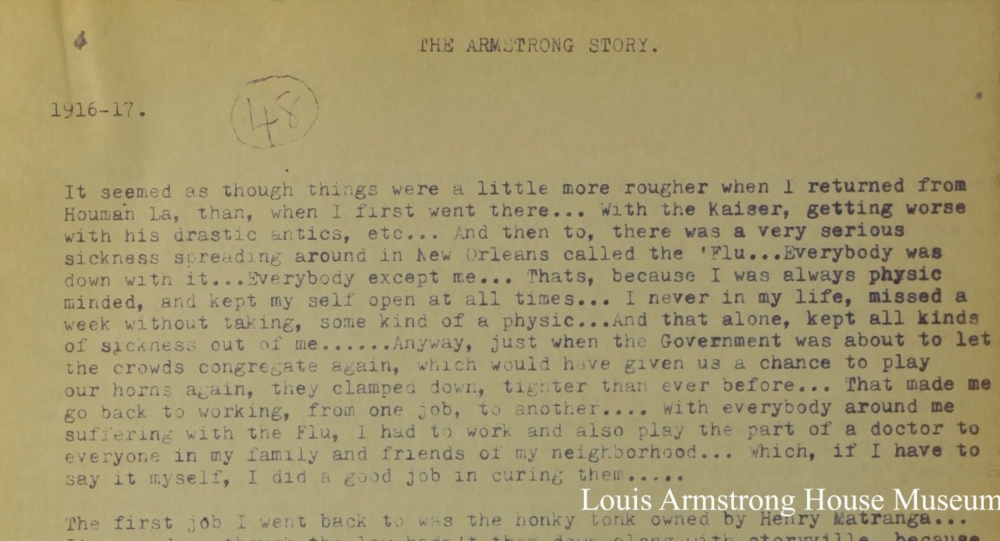
Born into poverty in New Orleans in 1901, and growing up during some of the most brutal years of segregation in the South, Louis Armstrong first lived with his grandmother, next in a “Colored Waif’s Home” after dropping out of school at age 11, then with his mother and sister in a home so small they had to sleep in the same bed. After already living through the first World War, he would go on to witness the Spanish Flu epidemic, the Great Depression, World War II, the Cold War, and the turbulent 1960s and the Vietnam conflict.
That’s a lot for one lifetime, though for much of it, Armstrong was a star and living legend who beat the odds and rose above his origins with will and talent. Even so, he suffered some severe ups and downs during the hard times, touring so much to cover his debts in the lean 1930s, for example, that he injured his lips and fingers, and finally moving to Europe when the mob came after him.
Armstrong’s descriptions of his experience of the 1918 influenza pandemic—as he remembers it in his 1954 memoir Satchmo: My Life in New Orleans—are almost jaunty, as you can partly see in the typescript page above from the Louis Armstrong House. But he remembered it from the perspective of a 17-year-old musician in robust health—who seemed to have some kind of resistance to the flu.
He devotes no more than two paragraphs to the flu, which hit the city hard in October of that year. According to the Influenza Encyclopedia, an online project documenting the flu in the U.S. between 1918–1919, New Orleans city authorities “acted immediately,” once they discovered the outbreak, arrived by cargo ship the month before.
On October 9th, the New Orleans Superintendent of Health, “with Mayor Martine Behrman’s consent and the blessing of state authorities… ordered closed all schools (public, private, and parochial, as well as commercial colleges), churches, theaters, movie houses, and other places of amusement, and [prohibited] public gatherings such as sporting events and public funerals and weddings.”
For a struggling young musician making a living playing clubs and riverboats, the closure of “other places of amusement” took a serious toll. The loss of livelihood is what seems to have hurt Armstrong the most when he returned to the city from touring, still unsure if the Great War would end.
When I came back from Houma things were much tougher. The Kaiser’s monkey business was getting worse, and, what is more, a serious flu epidemic had hit New Orleans. Everybody was down with it, except me. That was because I was physic-minded. I never missed a week without a physic, and that kept all kinds of sickness out of me.
Whatever “physic” helped Armstrong’s avoid infection, it wasn’t for lack of exposure. In lieu of playing the trumpet he began caring for the sick, since all of the hospitals, even those that would take black patients, were completely overcrowded.
Just when the government was about to let crowds of people congregate again so that we could play our horns once more the lid was clamped down tighter than ever. That forced me to take any odd jobs I could get. With everybody suffering from the flu, I had to work and play the doctor to everyone in my family as well as all my friends in the neighborhood. If I do say so, I did a good job curing them.
We might imagine some of those “odd jobs” were what we now call “essential”—i.e. low paid and high risk under the circumstances. He persevered and finally got a gig playing a “honky-tonk” that avoided a shut-down because it was “third rate,” and he “could play a lot of blues for cheap prostitutes and hustlers.” Few things could get Satchmo down, it seemed, not even a flu pandemic, but he was one of the lucky ones—luckily for the future of jazz. Only, we don’t have to imagine how hard this must have been for him. We just have to take a look around.
Learn more about the 1918 influenza epidemic in the U.S. at the Influenza Encyclopedia and read the rest of Armstrong’s account of his formative years at the Internet Archive.
Related Content:
Louis Armstrong Plays Historic Cold War Concerts in East Berlin & Budapest (1965)
Josh Jones is a writer and musician based in Durham, NC. Follow him at @jdmagness


Armstrong mentions in his autobiography that his mother gave him “Pluto Water” when he was a child. It was a very strong laxative, something Armstrong used all his life.
Mineral waters were often referred to as a “physic.” It was touted as a cure during the 1918 epidemic. There’s a newspaper clipping on the Wikipedia page for Pluto Water “Freedom from constipation is the surest preventative measure.” Certainly an example of fake cure.
I was just about to say that. Years later, when they stopped making Pluto Water, he switched to Swiss Kriss. Rather bizarrely, he was a very enthusiastic and vocal proponent of taking a daily laxative. My friend went to see him play in the 1960s, and they handed everybody a packet of Swiss Kriss on the way into the auditorium! That’s believing!